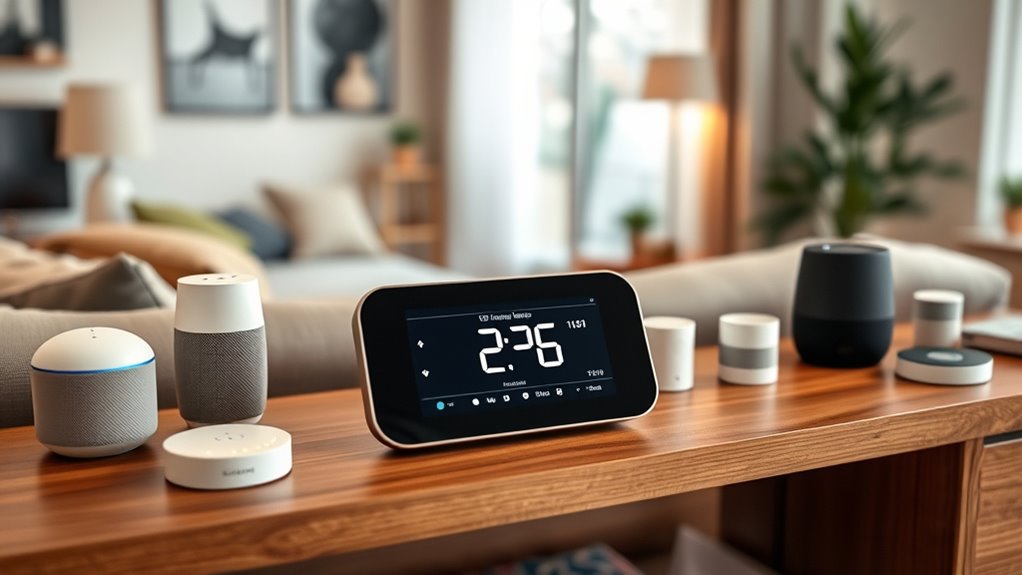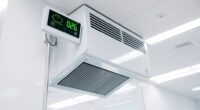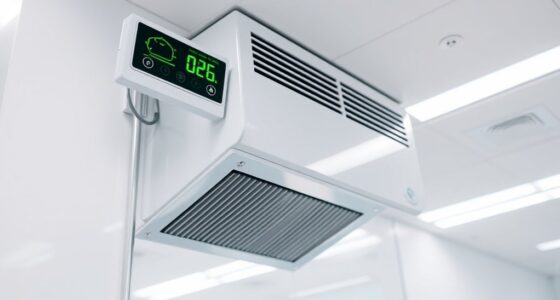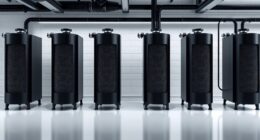Smart home air quality monitors connect easily with IoT ecosystems, giving you real-time data on indoor pollutants like dust and VOCs. They enable automation by triggering air purifiers or ventilation systems when pollution levels rise. Integration allows you to set rules, monitor trends remotely, and even use voice commands for adjustments. With proper calibration, these monitors deliver accurate information, helping you create healthier indoor environments effortlessly—staying ahead of potential air quality issues as you explore more about these smart solutions.
Key Takeaways
- IoT integration enables real-time monitoring, automation, and centralized control of air quality devices within smart home systems.
- Accurate sensor calibration ensures trustworthy data for automated responses like activating air purifiers.
- Smart monitors can set rules for device activation based on pollutant levels, enhancing indoor air health.
- User-friendly features like alerts, trend tracking, and voice control improve proactive air quality management.
- Combining calibration with automation optimizes system performance, creating healthier, smarter indoor environments.

As more homeowners seek to create healthier living environments, smart home air quality monitors have become essential tools for tracking indoor pollutants. These devices offer real-time insights into air quality levels, helping you identify issues like dust, volatile organic compounds (VOCs), and humidity fluctuations. When integrated into your IoT ecosystem, they can automate responses to improve air quality, such as activating air purifiers or adjusting ventilation systems. This seamless connection not only enhances comfort but also promotes better health.
A critical aspect of guaranteeing your air quality monitor functions accurately is proper sensor calibration. Over time, sensors can drift, leading to inaccurate readings that could misguide your decisions. Regular calibration, either manually or through automated updates, is crucial to maintain precision. When your sensors are well-calibrated, your monitor provides trustworthy data, enabling you to take timely actions, such as increasing air purification or ventilating a specific room. Many smart monitors now include features that alert you when calibration is needed, simplifying maintenance and ensuring consistent performance.
Air purification is a key component of maintaining good indoor air quality. When your monitor detects elevated levels of pollutants, it can trigger connected air purifiers to operate more intensively. This automation reduces your exposure to harmful particles and improves overall air freshness. Some advanced monitors can even differentiate between specific pollutants, allowing for targeted purification strategies. By integrating these monitors with smart air purifiers, you gain a proactive system that responds instantly to changes in air quality, creating a healthier environment without manual intervention.
Smart air monitors trigger purifiers for targeted, automatic air quality improvements.
Connecting your air quality monitor to your IoT setup allows for a thorough approach to home health management. You can set rules that activate or deactivate devices based on sensor data, monitor trends over time, and receive alerts on your smartphone. This integration ensures you’re always aware of your indoor environment and can act quickly if air quality deteriorates. Additionally, some systems incorporate features like voice control, enabling you to check air quality or adjust purification settings hands-free.
Maintaining accurate sensor readings is also essential because sensor calibration ensures your device continues to provide reliable data over time. Proper calibration prevents drift that could lead to misinterpretation of air quality levels, which is crucial for making informed decisions about home ventilation and purification. This process can often be managed through automated calibration features built into many modern monitors, reducing manual effort and increasing overall system reliability.
In essence, combining accurate sensor calibration with effective air purification strategies within your IoT ecosystem empowers you to create a smarter, healthier home. These monitors serve as the nerve center for indoor air management, providing real-time data and automation that keep your living space safe and comfortable. As technology advances, expect even more sophisticated integrations that make maintaining ideal indoor air quality easier than ever.
Frequently Asked Questions
Can These Monitors Detect All Indoor Air Pollutants Accurately?
You might wonder if these monitors detect all indoor air pollutants accurately. While they excel at measuring common pollutants like VOCs, CO2, and particulate matter, their air quality accuracy can vary for specific or less common pollutants. They are effective for general pollutant detection, but for thorough indoor air quality, consider models with advanced sensors. Keep in mind, no device can perfectly detect every pollutant, so regular maintenance and sensor calibration are essential.
Do They Require Professional Installation or Setup?
You can usually do a DIY setup for smart home air quality monitors, making installation simple without needing professional help. Many models come with user-friendly instructions and app guidance, so you can connect the device to your Wi-Fi and integrate it into your IoT ecosystem yourself. However, if you’re dealing with complex wiring or want optimized performance, opting for professional installation might be a better choice to guarantee everything is set up correctly.
How Long Do the Sensors Typically Last Before Needing Replacement?
Sensor durability varies, but you typically need to replace air quality monitor sensors every 6 to 12 months. The replacement frequency depends on usage and environmental factors; some sensors last longer if kept in stable conditions. Regular maintenance helps guarantee accurate readings, so keep an eye on performance indicators. By staying proactive, you’ll maintain ideal air quality monitoring and avoid unexpected sensor failures, ensuring your system functions effectively over time.
Are There Privacy Concerns With Data Collected by These Monitors?
Think of your data as a precious gem—worth protecting. Privacy concerns with these monitors are valid; they collect sensitive information about your home’s air quality. While most manufacturers implement strong data security measures, vulnerabilities can still exist, risking unauthorized access. Stay vigilant by choosing reputable brands, updating firmware regularly, and understanding privacy policies. Protect your home’s data as fiercely as you protect your home itself.
Can They Operate Effectively in Large or Multi-Room Homes?
Yes, smart home air quality monitors can operate effectively in large or multi-room homes. Look for models with multi-room compatibility and wide-range sensors to guarantee thorough coverage. These monitors often have the ability to connect across multiple zones, providing real-time data from various areas. Proper placement and network setup are essential to maximize accuracy and coverage, helping you maintain healthy indoor air quality throughout your entire home.
Conclusion
By integrating smart air quality monitors into your IoT ecosystem, you can effortlessly maintain a healthier home environment. Did you know that homes with connected air quality devices see up to a 30% improvement in indoor air safety? With real-time data and automation, you’re empowered to take immediate action, ensuring cleaner air for you and your loved ones. Embrace this technology to create a smarter, safer, and more comfortable living space today.










